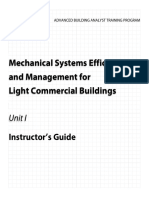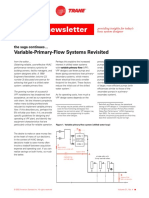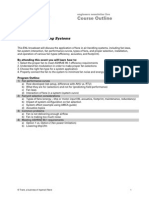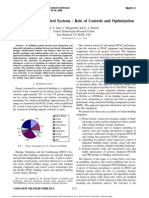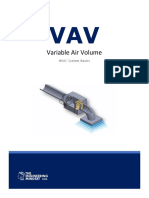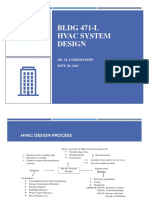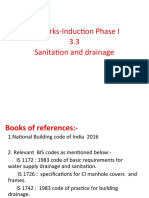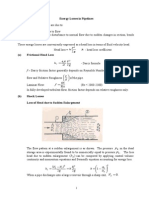HAP E-Help: Modeling Induction Beams in HAP v4.8
HAP E-Help: Modeling Induction Beams in HAP v4.8
Uploaded by
codefinderCopyright:
Available Formats
HAP E-Help: Modeling Induction Beams in HAP v4.8
HAP E-Help: Modeling Induction Beams in HAP v4.8
Uploaded by
codefinderOriginal Title
Copyright
Available Formats
Share this document
Did you find this document useful?
Is this content inappropriate?
Copyright:
Available Formats
HAP E-Help: Modeling Induction Beams in HAP v4.8
HAP E-Help: Modeling Induction Beams in HAP v4.8
Uploaded by
codefinderCopyright:
Available Formats
HAP e-Help
rev Jun 27, 2013 HAP v4.8
QB TIP 001
Modeling Induction Beams
in HAP v4.8
This HAP e-Help provides a high-level overview of induction beams, how they work and how to model them in HAP 4.8
(and later versions). The first half of the article explains how induction beams work. The second half deals with HAP
modeling. Please consult specific manufacturers’ application and product literature for application and design information.
Carrier offers the 36IB series induction beam system. Application information is available for downloading at
www.commercial.carrier.com or by contacting your local Carrier sales representative.
Ever since Willis Carrier designed the first modern air-conditioning system in 1902, Carrier has led the world in the
discovery of innovative ways to provide occupant comfort using sustainable technologies that emphasize efficiency and
environmental integrity. The induction beam of today is based on technology invented by Willis Carrier himself in the
1930s and refined by today’s pioneers to meet the needs of the high performance building of the future.
An induction beam (IB) takes a source of primary outdoor air at an inlet static pressure ranging from 0.4 to 0.8 in. wg.
Induction beams use conditioned (cooled and dehumidified) primary air in a quantity necessary to ensure good air quality
for the occupied area. The system distributes this primary air through a bank of specially designed aerodynamic nozzles
and discharges the air at a high velocity into a mixing chamber (see Figure 1). This creates a differential pressure which
enables a draw of room air across a coil. This imparts either cooling or heating to the induced air as it passes over the
coil. The primary air and induced air are mixed and discharged through a supply air louver in a Coanda effect air
distribution pattern at the ceiling.
Figure 1. Induction Beam Operating Diagram
Software Support: More eHelps:
software.systems@carrier.utc.com Page 1 Software Support Web Page
HAP e-Help
rev Jun 27, 2013 HAP v4.8
QB TIP 001
Modeling Induction Beams
in HAP v4.8
Buildings are dynamic, with latent cooling loads that change over time. A large group of people enter a conference room,
a door is left open, or air infiltrates the building envelope. These types of load fluctuations can cause condensation to
occur at the beam. A drain pan provides peace of mind and eliminates risk of condensation leaking into the space when
latent loads fluctuate. As an added benefit, the integrated drain pan on the Carrier ActivAIR™ induction beam allows the
specifying professional to design the system for use with chilled water that is below the dew point of the room. The ability
to use colder water means a greater capacity of cooling can be produced by each induction beam unit while reducing
chilled water distribution piping size and pump size.
With the ability to provide both sensible and latent cooling, the ActivAIR induction beam delivers more capacity per unit
than
sensible-only active chilled beams, so spaces can be conditioned using fewer units. The unit’s unique air distribution
design creates a uniform temperature within the space, thus providing a comfortable environment with no stratification. In
addition, ActivAIR requires only a simple thermostat connected to the coil valves, with no additional controls needed.
What are the advantages of induction beam systems over conventional designs? Induction beam systems provide a
cost-saving alternative to traditional commercial zoning systems for new construction or retrofit. They are suitable for use
in a variety of single- to multi-floor facilities, from schools and universities to healthcare, office spaces and all applications
in between. Compared with a system where the cooling duty is supplied entirely by air (all-air systems), an induction
beam system reduces the fan power requirements and space needed for air-handling plant equipment and ducting.
Induction beam systems have the following advantages:
High sensible load capacity
Decouples ventilation load from room sensible and latent loads resulting in better temperature control.
Typical supply air temperature is 64-66 °F exiting the induction beam, maximizing occupant comfort. Conventional
systems deliver cold air at 55 °F with the potential of creating drafts if poor mixing occurs
Constant volume airflow eliminates potential air dumping as compared to varying airflows in VAV systems.
Reduced fan power requirements (100-250 CFM/ton)
Increased space ventilation effectiveness (1.0) due to the good mixing (high induction ratio) of room air and supply air
Easily integrates with T-bar dropped ceiling grids
Some units offer directional air flow pattern control, optimizing comfort and preventing drafts
Minimal maintenance required in the occupied zone due to no moving parts in the induction beam
Low sound levels in the occupied zone
Induction beams include drain pans that offer the additional benefit of latent cooling at the terminal
What are the typical design conditions used for the chilled water and primary air for an induction beam system
and how are they controlled?
Induction beams can be used with chilled water entering temperatures ranging from 42° to 60° F due to inclusion of a full
drain pan to handle condensation.
The induction beam inlet primary air temperatures are typically between 55° and 70° F. The lower end of the ranges
should be used when the zone latent loads are higher, such as conference rooms, school classrooms, etc. while the
higher end of the range may be used in applications with low zone latent loads. Unlike active chilled beams, where the
latent cooling in the space needs to be handled solely by the primary air, the induction beam coil with a drain pan provides
additional latent cooling capacity in the space. This allows for primary air supply temperatures closer to neutral space air
temperature, reducing the risk of overcooling the space.
Software Support: More eHelps:
software.systems@carrier.utc.com Page 2 Software Support Web Page
HAP e-Help
rev Jun 27, 2013 HAP v4.8
QB TIP 001
Modeling Induction Beams
in HAP v4.8
Figure 2. Simplified Induction Beam System Diagram
How do you model an induction beam system in HAP v4.8 (and later versions)?
HAP v4.8 (and later versions) have the ability to directly model induction beam (IB) systems. Construction of a model for
an example IB system in HAP will be described in the following paragraphs to explain the basic modeling procedure.
For our modeling example, assume the induction beam system is a 4-pipe system with cooling and heating provided in
the beam terminals. The system serves four separate office zones. A Dedicated Outdoor Air System (DOAS)
preconditions outdoor ventilation air and supplies the treated air to the induction beam terminals. The DOAS will also use
an air-to-air energy recovery device to increase system energy efficiency.
To begin construction of the system model specify the following on the General tab of the HAP air system properties
window (Figure 3):
Equipment Type = Terminal Units
System Type = Induction Beam
Ventilation = Common Ventilation System
"Common ventilation system" is HAP's term for the DOAS unit. Note that the selection of a common ventilation system is
defaulted and locked because it is mandatory. It is what drives the operation of the induction beam terminals.
Software Support: More eHelps:
software.systems@carrier.utc.com Page 3 Software Support Web Page
HAP e-Help
rev Jun 27, 2013 HAP v4.8
QB TIP 001
Modeling Induction Beams
in HAP v4.8
Figure 3. Air System Properties, General Tab Figure 4. Vent System Components Tab,
Ventilation Air Data
Next, on the Vent System Components tab select the components in the left-hand panel as shown in Figure 4. Then,
working from top to bottom, review and revise data for each of the components:
1. Ventilation Air Data – Sample inputs are shown in Figure 4. Note that outdoor air dampers are marked as closed for
the unoccupied period. Because the ventilation fan needs to run to power the induction beam terminals, there can be
value in closing the outdoor air dampers during the unoccupied period to reduce the loads on the DOAS cooling and
heating coils. In cold climates this can result in substantial savings for heating energy.
Figure 5. Vent System Components Tab, Figure 6. Vent System Components Tab
Ventilation Reclaim Data Ventilation Cooling Coil Data
Software Support: More eHelps:
software.systems@carrier.utc.com Page 4 Software Support Web Page
HAP e-Help
rev Jun 27, 2013 HAP v4.8
QB TIP 001
Modeling Induction Beams
in HAP v4.8
2. Ventilation Reclaim – In this example our system includes an Energy Recovery Ventilator (ERV) wheel. As shown in
Figure 5, this device has the ability for both sensible and latent heat reclaim. The thermal efficiency and motor input
power are sample values. Be sure to obtain this data from manufacturer's product data if you are modeling specific
equipment in your system.
3. Ventilation Cooling Coil – Sample inputs are shown in Figure 6. Induction beam terminals that include a drain pan
can operate as total cooling devices, handling both sensible and latent loads in the zone. For this reason control of
DOAS supply air temperature and humidity is not as critical as it is for an active chilled beam terminal, which is a
sensible-only device. The DOAS generally is designed to handle the outdoor ventilation air sensible and latent loads,
and often part of the zone sensible and latent. A DOAS primary air leaving air temperature (LAT) setpoint of 60 F will
be used in this example. Because 60 F is below zone-neutral conditions it will meet the ventilation sensible load and
part of the zone sensible loads.
4. Ventilation Heating Coil – We will use the same DOAS supply air discharge setpoint for heating as for cooling (see
Figure 7). Therefore when discharge air from the ERV is below 60 F it will be heated to maintain a 60 F discharge
temperature from the DOAS unit. When it is above 60 F it will be cooled to maintain a 60 F discharge temperature.
5. Dehumidification Control – Our sample system will use a humidistat at the DOAS unit discharge to control the
humidity of the primary supply air. A maximum relative humidity (RH) setpoint of 75% will be used (Figure 8). When
the discharge RH rises above 75% the ventilation cooling coil will sub-cool the air to condense additional moisture and
bring the humidity down to 75%. If necessary, the heating coil will provide dehumidification reheat to bring the DOAS
discharge temperature back up to the 60 F setpoint temperature.
If the zone cooling thermostat setpoint is 75 F, primary air at 60 F and 75% is slightly below zone neutral. As a result,
the DOAS cooling coil will not only handle the ventilation sensible and latent load, but will contribute to meeting part of
the zone sensible and latent loads.
Figure 7. Vent System Components Tab, Figure 8. Vent System Components Tab
Ventilation Heating Coil Data Dehumidification Control Data
Software Support: More eHelps:
software.systems@carrier.utc.com Page 5 Software Support Web Page
HAP e-Help
rev Jun 27, 2013 HAP v4.8
QB TIP 001
Modeling Induction Beams
in HAP v4.8
6. Ventilation Fan – Sample fan inputs are shown in Figure 9. A forward curved fan with variable frequency drive will
be used. The total static pressure of 5 in wg represents static needed to overcome the pressure drops of the ERV,
filters, coils, and ductwork, and to supply the required static pressure at the induction beam terminal nozzles. The
efficiency is representative for this type of fan.
Note that an unoccupied airflow rate of 50% of design is also specified. In many applications, primary airflow for the
induction beam system can be turned down during unoccupied times when thermostat setpoints are set up or set
back and zone load levels are low. The DOAS can still provide sufficient dehumidification with the reduced airflow to
keep room humidities under control. When airflow turndown is used, airflow can be reduced to between 50% and
95% of design flow. HAP will not allow airflow to be turned down more than 50%. The reduced airflow combined with
the ventilation fan VFD will yield significant fan energy savings versus active chilled beam systems which cannot turn
down unoccupied airflow rates.
7. Duct System – The example system will use a ducted return. For the sake of simplicity we did not specify duct
leakage or duct heat gain. (Screen image of duct system inputs not shown).
8. Exhaust Fan – Finally, the exhaust fan will be the same type as the ventilation fan (forward curved, variable
frequency drive). The total static pressure of 1.5 in wg represents the pressure drops of the ERV and the ductwork.
(Screen image of exhaust fan inputs not shown).
Figure 9. Vent System Components Tab, Figure 10. Zone Components Tab
Ventilation Fan Data Thermostats Data
Next we move to the Zone Components tab shown in Figure 10. Working from top to bottom through the categories of
data shown in the left panel of this tab, review and revise the following data:
1. Spaces – Assign spaces to the zones in the system. Our example system has four zones, each with one space.
(Screen image of this data not shown).
Software Support: More eHelps:
software.systems@carrier.utc.com Page 6 Software Support Web Page
HAP e-Help
rev Jun 27, 2013 HAP v4.8
QB TIP 001
Modeling Induction Beams
in HAP v4.8
2. Thermostats – Assign the thermostat setpoints and thermostat schedule. Sample values are shown in Figure 10.
Note that unoccupied cooling is specified as "available". This is important because the system needs the ability to
continue to dehumidify primary air during the unoccupied hours to keep room humidity under control.
3. Common Data – This data category is used to specify the capability of the induction beam terminals. As shown in
Figure 11, the terminals in our example have both cooling and heating capability.
4. Terminal Units Data – In this final category of data you can define one set of values applying to all induction beam
terminals, or can specify individual data for each zone's terminal equipment. This is done via the "All zones the same"
check box in the upper left (Figure 12). In our example, we'll specify one set of data applying to all zones.
The terminal type will always be "induction beam". The "induction ratio" is the ratio of total supply airflow produced by
the terminal to primary airflow entering the terminal. Typical values range from 2.7 to 4.0. If you have specific
induction beam equipment in mind, consult manufacturer's data to determine the appropriate value. A representative
value of 3.0 is used in our example. Finally, specify the bypass factor that is representative for the terminal cooling
coil. A value of 0.090 is used in our example.
Figure 11. Zone Components Tab, Figure 12. Zone Components Tab
Common Data Terminal Unit Data
At this point the induction beam air-side system is fully defined and can be saved and then used in system design and
energy analysis calculations.
What about the Chilled Water Plant?
A chilled water plant serving induction beam air systems uses a single supply water temperature, typically in the 42 F to
45 F range. There are no special modeling requirements. The plant would be modeled using the same principles as a
plant serving conventional systems such as VAV air handlers.
Software Support: More eHelps:
software.systems@carrier.utc.com Page 7 Software Support Web Page
HAP e-Help
rev Jun 27, 2013 HAP v4.8
QB TIP 001
Modeling Induction Beams
in HAP v4.8
Conclusion
Induction beams are extremely flexible and enhance the savings and effectiveness of primary air systems such as those
using dedicated outdoor air. When using induction beams, the primary air system, which includes the dedicated outdoor
air handling unit, and the primary air and exhaust air ductwork, can be sized to handle only the required ventilation
outdoor air. This reduces the size of the equipment and ductwork compared to conventional systems, making it easier to
fit into a building space. This also reduces the energy required to supply the ventilation air to the building. The total room
air circulation is created solely by the induction process within the terminal; therefore, there is no motor requiring an
electric power source or maintenance for a fan and motor. As a result, the induction beam is a very quiet and efficient
way to provide comfort in a space.
The manufacturer's design application literature should always be consulted when designing an induction beam system.
Resources
1) Induction Beams, Engineered Comfort for Today's Buildings, Form 04-581068-01, Carrier Corporation, Syracuse, NY
2) 36IB Induction Beams Product Literature; Form 36IB-1PD; May 2012; Carrier Corporation, Syracuse, NY.
3) DOAS & Humidity Control; Larranaga, Michael D., Beruvides, Mario G., Ph.D., P.E., Holder, H.W., Karunasena,
Enusha, Ph.D. & Straus, David C, Ph.D.; ASHRAE Journal, May 2008; pp. 34-39.
Software Support: More eHelps:
software.systems@carrier.utc.com Page 8 Software Support Web Page
You might also like
- Price Engineer's HandbookDocument4 pagesPrice Engineer's Handbooksah_462573459No ratings yet
- CAN-QUEST Modelling Guide - Mar31 2016Document193 pagesCAN-QUEST Modelling Guide - Mar31 2016bjpwongNo ratings yet
- Accumulator (Blade Cushion) - Test and ChargeDocument8 pagesAccumulator (Blade Cushion) - Test and ChargeVargas LuisNo ratings yet
- Varying ViewsDocument5 pagesVarying Viewsforevertay2000No ratings yet
- HAP 4.50 Leed Quick Energy AnalysisDocument8 pagesHAP 4.50 Leed Quick Energy AnalysisAARON GARRIDONo ratings yet
- Control Systems ResourceS12Document5 pagesControl Systems ResourceS12Anonymous XFh6mcKNo ratings yet
- SAE - J-1678 - Low Voltage Ultra Thin Wall Primary CableDocument31 pagesSAE - J-1678 - Low Voltage Ultra Thin Wall Primary CableFrancisco Eduardo Almeida CardenasNo ratings yet
- Werther - Fluidized Bed ReactorsDocument48 pagesWerther - Fluidized Bed ReactorsLeo Dorsey0% (1)
- Using Hap460 For LeedDocument6 pagesUsing Hap460 For LeedSid KherNo ratings yet
- Low Heating Costs: QB Tip 001Document8 pagesLow Heating Costs: QB Tip 001maheshNo ratings yet
- Hap Ehelp 029Document8 pagesHap Ehelp 029Abed NaemNo ratings yet
- Openstudio 1.9.0 Basic Workflow Guide: Openstudio Sketchup Plug-InDocument50 pagesOpenstudio 1.9.0 Basic Workflow Guide: Openstudio Sketchup Plug-InDanielNo ratings yet
- Hap Ehelp 009 1Document3 pagesHap Ehelp 009 1maheshNo ratings yet
- Unit 1 InstructorDocument262 pagesUnit 1 InstructorAvk SanjeevanNo ratings yet
- Energy PlusDocument29 pagesEnergy Plusbloodpaint87No ratings yet
- Equest Tutorial v364 PDFDocument151 pagesEquest Tutorial v364 PDFRaniPaviNo ratings yet
- How To Import Data From Template Projects: QB Tip 001Document3 pagesHow To Import Data From Template Projects: QB Tip 001maheshNo ratings yet
- OpenStudio Product Overview 1 enDocument15 pagesOpenStudio Product Overview 1 enPaco De Peco EdmspjpNo ratings yet
- Openstudio Retrofit TutorialDocument8 pagesOpenstudio Retrofit Tutorialbloodpaint87No ratings yet
- ASHRAE Presentation:: VRF OverviewDocument41 pagesASHRAE Presentation:: VRF OverviewAnonymous o7Do2G0hTlNo ratings yet
- TDP-903 Life Cycle Costing For Hvac SystemsDocument104 pagesTDP-903 Life Cycle Costing For Hvac SystemsMaher OthmanNo ratings yet
- Adm Apn005 enDocument8 pagesAdm Apn005 enNeal JohnsonNo ratings yet
- PP4 - Advance HVAC Course OEADocument16 pagesPP4 - Advance HVAC Course OEABassel El Sayed AliNo ratings yet
- Understanding Electrical Load EstimationDocument33 pagesUnderstanding Electrical Load EstimationDelia Remerata ElmidoNo ratings yet
- PST FHT 2009Document109 pagesPST FHT 2009tomaz_filhoNo ratings yet
- eQUEST TUTORIAL #1Document12 pageseQUEST TUTORIAL #1Khamis YHNo ratings yet
- Workshop 5.1: Global Mesh Controls: Introduction To ANSYS MeshingDocument31 pagesWorkshop 5.1: Global Mesh Controls: Introduction To ANSYS MeshingDaniloCardenasNo ratings yet
- ASHRAE Elearning Course List - Order FormDocument4 pagesASHRAE Elearning Course List - Order Formsaquib715No ratings yet
- Trane ENL Fans in Air-Handling SystemsDocument68 pagesTrane ENL Fans in Air-Handling SystemsADIPESHNo ratings yet
- Submittal GREENHECK PDFDocument72 pagesSubmittal GREENHECK PDFLuis DomdNo ratings yet
- Building HVAC Control Systems - Role of Controls and OptimizationDocument6 pagesBuilding HVAC Control Systems - Role of Controls and OptimizationMohammad Hafiz OthmanNo ratings yet
- Troubleshooting Humidity & Moisture Problems in BuildingsDocument6 pagesTroubleshooting Humidity & Moisture Problems in BuildingsMoriyasuNguyenNo ratings yet
- Cop V/S Eer V/S SeerDocument7 pagesCop V/S Eer V/S SeerRaj Deep TiwariNo ratings yet
- Modeling Guide For Daikin VRV in TRACE 700Document20 pagesModeling Guide For Daikin VRV in TRACE 700TienNguyenNo ratings yet
- Engineers Newsletter: Keeping The "Free" in Free-CoolingDocument8 pagesEngineers Newsletter: Keeping The "Free" in Free-CoolingJoshuaNo ratings yet
- Trane Newsletters - VAV's With Open Ceiling Renovations ADM-APN079-ENDocument8 pagesTrane Newsletters - VAV's With Open Ceiling Renovations ADM-APN079-ENRobby RenzNo ratings yet
- SODECA3 Sodeca Fans, Industrial VentilationDocument5 pagesSODECA3 Sodeca Fans, Industrial Ventilationbzkizo_sbbNo ratings yet
- APC CoolingDocument42 pagesAPC CoolingElson LinNo ratings yet
- Supply Fan Control For Constant Air Volume Air Handling UnitsDocument6 pagesSupply Fan Control For Constant Air Volume Air Handling UnitskdpmansiNo ratings yet
- Hap Ehelp 024Document6 pagesHap Ehelp 024Abed NaemNo ratings yet
- Cadprofi 2021 enDocument67 pagesCadprofi 2021 enPetru CorduneanuNo ratings yet
- So-Pro: Solar Process HeatDocument28 pagesSo-Pro: Solar Process Heat-roseira-No ratings yet
- 383 NO28 EnergyModeliing 2013Document23 pages383 NO28 EnergyModeliing 2013Parvez SaifNo ratings yet
- LEED - v4.1 - ID - C - Guide - For - April - 2023 - ENERGYDocument30 pagesLEED - v4.1 - ID - C - Guide - For - April - 2023 - ENERGYTomaszNo ratings yet
- Decoupling OA and Space Thermal Control: Technical FeatureDocument4 pagesDecoupling OA and Space Thermal Control: Technical FeatureBhagyashree KadaleNo ratings yet
- I HtgMKTGLiteraturePDFsModine7-115 0Document24 pagesI HtgMKTGLiteraturePDFsModine7-115 0huron11100% (1)
- Apachesim Ve 2014 Session A Training Notes PDFDocument23 pagesApachesim Ve 2014 Session A Training Notes PDFKa Hung LeungNo ratings yet
- Variable Air Volume: HVAC System BasicsDocument10 pagesVariable Air Volume: HVAC System Basicsdexture harddriveNo ratings yet
- Etna - Fire Pump Systems in Accordance With EN 12845 Standard Technical LeafletDocument28 pagesEtna - Fire Pump Systems in Accordance With EN 12845 Standard Technical LeafletRedha Sabr100% (1)
- Controls TDP 20181106Document34 pagesControls TDP 20181106jose antonioNo ratings yet
- Heating & Cooling IDeas - Heat Pumps and Heat Recovery Chillers CatalogueDocument9 pagesHeating & Cooling IDeas - Heat Pumps and Heat Recovery Chillers CatalogueAkhil VijaiNo ratings yet
- APN069 ParkingGarage WEB 1 8 15Document8 pagesAPN069 ParkingGarage WEB 1 8 15Rafael Leonardo GomezNo ratings yet
- 1-BLDG 471 Intro HVAC System DesignDocument15 pages1-BLDG 471 Intro HVAC System DesignSara HayekNo ratings yet
- Uponor Contec TABS Design Basics: Thermally Active Building SystemsDocument20 pagesUponor Contec TABS Design Basics: Thermally Active Building Systemsjamppajoo2No ratings yet
- Rana - Ashrae Final-1Document27 pagesRana - Ashrae Final-1metubeNo ratings yet
- JCI OldMetasysVAVDocument92 pagesJCI OldMetasysVAVwillgohnNo ratings yet
- Standard 90.1-2016 Determination TSDDocument65 pagesStandard 90.1-2016 Determination TSDdemet cioncaNo ratings yet
- E20s Features Hap491-1Document10 pagesE20s Features Hap491-1Saman HassanzadehNo ratings yet
- Active Passive Beams Engineering GuideDocument48 pagesActive Passive Beams Engineering GuideAshraf Adel Nashed ZakiNo ratings yet
- Mechanical System Modeling Guide: Variable Refrigerant Flow (VRF) SystemsDocument15 pagesMechanical System Modeling Guide: Variable Refrigerant Flow (VRF) SystemsAnonymous 73gEYyEtLNo ratings yet
- Product Catalogue: Leading The Fight Against FireDocument94 pagesProduct Catalogue: Leading The Fight Against FirecodefinderNo ratings yet
- Urinals: USWN810BE USWN810BDocument1 pageUrinals: USWN810BE USWN810BcodefinderNo ratings yet
- Dce603ue SpecDocument1 pageDce603ue SpeccodefinderNo ratings yet
- Report Sanitary Plumbing Drainage and Pipe SizingDocument30 pagesReport Sanitary Plumbing Drainage and Pipe SizingcodefinderNo ratings yet
- အညတရသိုင္းသမားႏွင့္လွ်ိဳ႕ဝွက္အုတ္ဂူ (၁) မိုးေက်ာ္သူDocument114 pagesအညတရသိုင္းသမားႏွင့္လွ်ိဳ႕ဝွက္အုတ္ဂူ (၁) မိုးေက်ာ္သူcodefinderNo ratings yet
- Supplementary Information To The WSAA Sewerage Pumping Station Code of AustraliaDocument21 pagesSupplementary Information To The WSAA Sewerage Pumping Station Code of AustraliacodefinderNo ratings yet
- မိုးေက်ာ္သူ-ၾကယ္ေႂကြဟန္ႏွင့္ ဆည္းဆာမာန္ (၁)Document104 pagesမိုးေက်ာ္သူ-ၾကယ္ေႂကြဟန္ႏွင့္ ဆည္းဆာမာန္ (၁)codefinderNo ratings yet
- အညတရသိုင္းသမားႏွင့္လွ်ိဳ႕ဝွက္အုတ္ဂူ (၃) မိုးေက်ာ္သူ PDFDocument95 pagesအညတရသိုင္းသမားႏွင့္လွ်ိဳ႕ဝွက္အုတ္ဂူ (၃) မိုးေက်ာ္သူ PDFcodefinderNo ratings yet
- Retrofit Measures For COVID-19: Smart Hospital ProjectDocument17 pagesRetrofit Measures For COVID-19: Smart Hospital ProjectcodefinderNo ratings yet
- Control System and Solutions - Global Case Study Collection - JIV1901 PDFDocument11 pagesControl System and Solutions - Global Case Study Collection - JIV1901 PDFcodefinderNo ratings yet
- အညတရသိုင္းသမားႏွင့္လွ်ိဳ႕ဝွက္အုတ္ဂူ (၁၂) မိုးေက်ာ္သူ PDFDocument96 pagesအညတရသိုင္းသမားႏွင့္လွ်ိဳ႕ဝွက္အုတ္ဂူ (၁၂) မိုးေက်ာ္သူ PDFcodefinderNo ratings yet
- Ceiling Cassette Indoor Unit Engineering ManualDocument138 pagesCeiling Cassette Indoor Unit Engineering Manualcodefinder100% (1)
- Gs Overview Vol 1Document264 pagesGs Overview Vol 1codefinderNo ratings yet
- 04 2020 PDFDocument116 pages04 2020 PDFcodefinderNo ratings yet
- VRV Control Solutions PDFDocument20 pagesVRV Control Solutions PDFcodefinderNo ratings yet
- VKM-GM Series VKM-G Series: DX-coil and Humidifier DX-coilDocument9 pagesVKM-GM Series VKM-G Series: DX-coil and Humidifier DX-coilcodefinderNo ratings yet
- Project Name: North Dagon Hospitsl 10/21/2020Document2 pagesProject Name: North Dagon Hospitsl 10/21/2020codefinderNo ratings yet
- Heat Reclaim Ventilator VKMDocument2 pagesHeat Reclaim Ventilator VKMcodefinderNo ratings yet
- Q190814 FXMQ300 Product Leaflet-FA - Web - CleanedDocument2 pagesQ190814 FXMQ300 Product Leaflet-FA - Web - CleanedcodefinderNo ratings yet
- Installation Instructions Rheem Commercial Heat Pump Air To Water PN 26845 Rev A 190806Document84 pagesInstallation Instructions Rheem Commercial Heat Pump Air To Water PN 26845 Rev A 190806codefinderNo ratings yet
- Guide To Good Industry Practices For LPG in Commercial KitchensDocument58 pagesGuide To Good Industry Practices For LPG in Commercial KitchenscodefinderNo ratings yet
- LNG RegasificationDocument22 pagesLNG RegasificationVu Duc Nguyen100% (1)
- Fluidized Bed A14Document8 pagesFluidized Bed A14lovelygirl_256No ratings yet
- Catalytic ReformingDocument7 pagesCatalytic ReformingElena Raluca DraguNo ratings yet
- JE Works-Induction Phase I 3.3 Sanitation and DrainageDocument42 pagesJE Works-Induction Phase I 3.3 Sanitation and DrainageThiyagarajan kNo ratings yet
- Hydraulic and Pneumatic Control ValvesDocument24 pagesHydraulic and Pneumatic Control ValvesSyama TripathyNo ratings yet
- Use of CFD in Design: A Tutorial: Sean M. Mcguffie, P.E. Michael A. Porter, P.E. Thomas T. HirstDocument110 pagesUse of CFD in Design: A Tutorial: Sean M. Mcguffie, P.E. Michael A. Porter, P.E. Thomas T. HirstSeyfullahYıldızNo ratings yet
- KWI DAF Minicell BrochureDocument4 pagesKWI DAF Minicell Brochurei.tultaevNo ratings yet
- M11 ThermalDocument22 pagesM11 ThermalAyush ChoudharyNo ratings yet
- CSB PM - Catastrophic Vessel Overpressurization Sonat ExplorationDocument24 pagesCSB PM - Catastrophic Vessel Overpressurization Sonat Explorationrieza_f100% (1)
- Jase 201609 19 3 01Document8 pagesJase 201609 19 3 01Rafael SalgadoNo ratings yet
- Ch2 ProblemsDocument56 pagesCh2 ProblemsSayyadh Rahamath Baba0% (1)
- UTS Simulasi Desain Proses 2023 - RvsDocument2 pagesUTS Simulasi Desain Proses 2023 - RvsAnita BudiNo ratings yet
- Aerodynamic DragDocument3 pagesAerodynamic DragiwilleatyNo ratings yet
- Chandra Gupt Porwal, CMD, NIMDC PVT LTD.Document13 pagesChandra Gupt Porwal, CMD, NIMDC PVT LTD.CHANDRA GUPT PORWALNo ratings yet
- Chapter 5 (Production of Very Low Temperature)Document19 pagesChapter 5 (Production of Very Low Temperature)Kshitij PanditNo ratings yet
- Comparison - Choke Equation Schlumberger vs. Texas A & I ModelsDocument16 pagesComparison - Choke Equation Schlumberger vs. Texas A & I ModelsJunaid MateenNo ratings yet
- Rheology Testing of Polymers and The Determination of Properties Using Rotational Rheometers and CapDocument12 pagesRheology Testing of Polymers and The Determination of Properties Using Rotational Rheometers and CapDevashish AgnihotriNo ratings yet
- Energy Losses in PipelinesDocument2 pagesEnergy Losses in PipelinesYathu89No ratings yet
- Chilled Water Fan Coil UnitPart-11Document1 pageChilled Water Fan Coil UnitPart-11Enak CenirNo ratings yet
- XMTRP 1703010Document5 pagesXMTRP 1703010Aditya Whisnu HeryudhantoNo ratings yet
- End Term ALLDocument31 pagesEnd Term ALLJulie Anne CristalesNo ratings yet
- Sec 3 Pure Physics Test On Thermal Energy Transfer and Thermal Properties of MatterDocument12 pagesSec 3 Pure Physics Test On Thermal Energy Transfer and Thermal Properties of Matteralibabagoat1No ratings yet
- Basic Instructions For Joining Permaglass FRP BORE CASINGDocument2 pagesBasic Instructions For Joining Permaglass FRP BORE CASINGademgsNo ratings yet
- 9C304 19Document37 pages9C304 19SHEKHAR100% (1)
- Integrated Approach To Water/ Wastewater Treatment at Zero Liquid Discharge, Combined Cycle Power PlantsDocument6 pagesIntegrated Approach To Water/ Wastewater Treatment at Zero Liquid Discharge, Combined Cycle Power PlantsNoureddine MerahNo ratings yet
- Heat Transfer Co-Efficient CEDocument17 pagesHeat Transfer Co-Efficient CEjaanabhenchodNo ratings yet
- Quiz1 - Fluidmechanics1 (DDA80066)Document7 pagesQuiz1 - Fluidmechanics1 (DDA80066)silent spritsNo ratings yet
- Pressure LossDocument33 pagesPressure LossFreddy Mendoza CoronelNo ratings yet
- RefinedDocument2 pagesRefinedminh nguyenNo ratings yet













